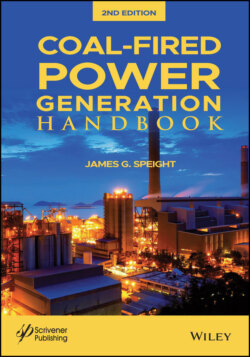Читать книгу Coal-Fired Power Generation Handbook - James Speight G., James G. Speight - Страница 105
4.4.4 Moisture Content
ОглавлениеMoisture present in the coal is known to influence spontaneous heating in a stockpile insofar as the moisture affects ventilation (air flow) and pyrite reactivity. The higher the inherent (equilibrium) moisture content, the higher the heating tendency. The lower the ash free Btu, the higher the heating tendency. Coal with high oxygen content typically has a higher tendency to self-heat than coal of lower oxygen content. Thus, there appears to be an interaction between oxygen functions in the coal and aerial oxygen leading to a higher potential for formation of the coal-oxygen complex as the first stage of the self-heating process leading to a higher tendency for spontaneous ignition of the high-oxygen coal.
The effect of moisture on the self-ignition is twofold, thus (i) the vaporization of moisture consumes energy and hence the ignition process is impeded, (ii) promotion of self- ignition by the wetting of materials prone to evolution of heat during the moisture adsorption has been observed (Gray, 1990).
In addition to the heat of wetting, moisture simply blocks the access of oxygen through the coal pores. The water vapor diffusing outwards through the pores reduces the oxygen partial pressure and hence lowers the rate of the reaction or the polar water molecules attach to the reactive sites in coal (Jones, 1998).
The heat of condensation of coal in a stockpile can cause a rise in temperature in the pile, which is dependent upon the coal rank (Berkowitz and Schein, 1951). In addition, if dry screened coal is used as a storage-pile base for a shipment of wet coal, ignition can (or will) occur at the wet-dry interface of the two loads (Berkowitz and Speight, 1973). However, the more rapid oxidation occurring in high-moisture coals may be basically a function of coal rank rather than moisture content, since low-rank (high-oxygen) coal is usually also higher in moisture content.
Wetting and drying coal repeatedly may make it more susceptible to combustion. The actions of water may break up the coal, especially after freezing and thawing. Wet coal should not be piled or mixed with dry coal. Nor should coal be stored on a damp base. After heavy rains and snows (with accompanying snow melt) the stockpile should be inspected and observed for potential fires.
Thus, the moisture content of coal is also an important parameter in the rate of heat generation of the coal. Drying coal is an endothermic process, in which heat is absorbed, and the temperature of the coal is lowered. The adsorption of moisture on a dry coal surface is an exothermic process, with a heat-producing reaction. If coal is partially dried during its mining, storage, or processing, coal has the potential to re-adsorb moisture, thus producing heat. Therefore, the higher the moisture contents of the coal, the greater the potential for self-heating to occur. The most dangerous scenario for spontaneous combustion is when wet and dry coals are combined; the interface between wet and dry coal becomes a heat exchanger (Berkowitz and Schein, 1951; Smith et al., 1991). If coal is either completely wet or completely dry, the risk is substantially reduced. In general, the moisture content of coal increases with decreasing rank.
